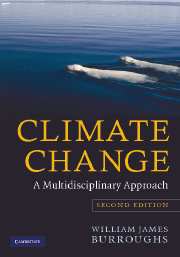Book contents
- Frontmatter
- Contents
- Preface to the second edition
- 1 Introduction
- 2 Radiation and the Earth's energy balance
- 3 The elements of the climate
- 4 The measurement of climate change
- 5 Statistics, significance and cycles
- 6 The natural causes of climate change
- 7 Human activities
- 8 Evidence of climate change
- 9 Consequences of climate change
- 10 Modelling the climate
- 11 Predicting climate change
- Glossary
- Bibliography
- Index
1 - Introduction
Published online by Cambridge University Press: 05 June 2012
- Frontmatter
- Contents
- Preface to the second edition
- 1 Introduction
- 2 Radiation and the Earth's energy balance
- 3 The elements of the climate
- 4 The measurement of climate change
- 5 Statistics, significance and cycles
- 6 The natural causes of climate change
- 7 Human activities
- 8 Evidence of climate change
- 9 Consequences of climate change
- 10 Modelling the climate
- 11 Predicting climate change
- Glossary
- Bibliography
- Index
Summary
There is always an easy solution to every human problem – neat, plausible and wrong.
H. L. MenkenThe climate has always been changing. On every timescale, since the Earth was first formed, its surface conditions have fluctuated. Past changes are etched on the landscape, have influenced the evolution of all life forms, and are a subtext of our economic and social history. Current climate changes are a central part of the debate about the consequences of human activities on the global environment, while the future course of the climate may well exert powerful constraints on economic development, especially in developing countries. So, for many physical and social sciences, climate change is an underlying factor that needs to be appreciated in understanding how these disciplines fit in to the wider picture. The aim of this book is to provide a balanced view to help the reader to give the right weight to the impact of climate change on their chosen disciplines. This will involve assessing how the climate can vary of its own accord and then adding in the question of how human activities may lead to further change.
The first thing to get straight is that there is nothing simple about how the climate changes. While the central objective of the book is to make the essence of the subject accessible, it is no help to you, the reader, to duck the issues. All too often people try to reduce the debate to what they see as the essential features.
- Type
- Chapter
- Information
- Climate ChangeA Multidisciplinary Approach, pp. 1 - 10Publisher: Cambridge University PressPrint publication year: 2007



